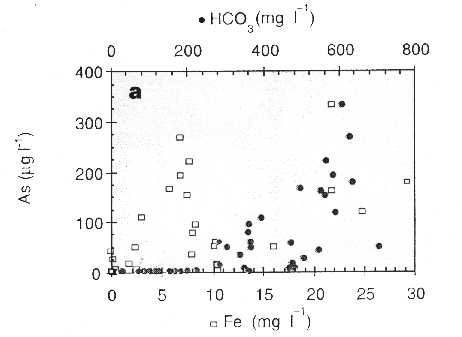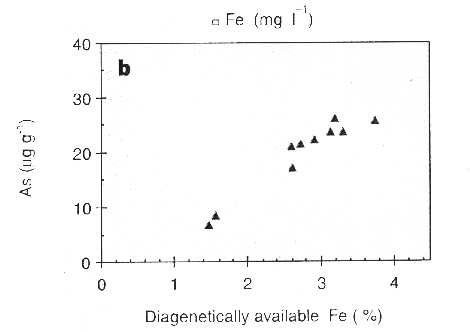|
Reprinted with permission from Nature, Volume 395, page 338, 24th Sep., 1998. Copyright (1998) Macmillan Magazines Limited (email nature@nature.com) Arsenic Poisoning of Bangladesh GroundwaterIn Bangladesh and West Bengal, alluvial Ganges aquifers used for public water supply are polluted with naturally-occurring arsenic; which adversely affects the health of millions of people. Here we show that the arsenic derives from reductive dissolution of arsenic-rich iron oxyhydroxides which in turn are derived from weathering of base-metal sulphides. This finding means that it should be possible, by sedimentological study of the Ganges alluvial sediments, to guide the placement of new water wells so that they will be less polluted with arsenic. As many as a million water wells Bangladesh and West Bengal, drilled into Ganges alluvial deposits, may be contaminated with arsenic1-6. Measured concentrations1-6 range up to 1000 m g l-1, which is above the limits set for Bangladesh drinking water (50 m g l-1) or recommended by the World Health Organisation (10 m g l-1). Consumption of this water has lead to widespread death and disease1-6. Arsenic has been reported to derive from the oxidation of arsenic-rich pyrite in the aquifer sediments as atmospheric oxygen invades the aquifer in response to a lowering of the water level by abstraction4,5. This explanation is not consistent with the following observations3, made on 46 wells, typical of those in Bangladesh, that were sampled during May and June, 1997: in oxic (shallow) wells, arsenic concentrations are mostly below 50 m g l-1; in anoxic waters, arsenic concentrations (= 260 m g l-1) correlate with concentrations of dissolved iron (= 29 mg l-1) and bicarbonate ( Fig.1a); arsenic concentrations increase with depth in wells at Manikganj, Faridpur, and Tungipara. These observations suggest that arsenic is released when arseniferous iron-oxyhydroxides are reduced in anoxic groundwater6, a process that solubilises iron, and its absorbed load, and increases bicarbonate concentrations. Sedimentary iron oxyhydroxides are known to scavenge arsenic7 and, in aquifer sediments, concentrations of diagenetically-available iron (£ 3.7%) and arsenic (£ 26 ppm) correlate well3 (Fig.1b). The arsenic-rich groundwater is mostly restricted to the alluvial aquifers of the Ganges delta3,6, so the source of arsenic-rich iron oxyhydroxides must lie in the Ganges source region upstream of Bangladesh. Weathered base-metal deposits occur6,8,9,10 in the Ganges basin (Bihar, Uttar Pradesh, West Bengal), so weathering of these arsenic-rich base-metal sulphides must have supplied arsenic-rich iron oxyhydroxide to downstream Ganges sediments during Late Pleistocene-Recent times. The arsenic-rich iron oxyhydroxides are now being reduced, causing the present problem. Reduction is driven by concentrations of sedimentary organic matter3 of up to 6%. A knowledge of the sedimentary architecture of, and of the distribution of iron, arsenic and reductant carbon in, Ganges alluvial sediments will enable a predictive model to be developed to guide future aquifer development in a way that minimises arsenic pollution. Furthermore, on oxidation dissolved iron precipitates as iron oxyhydroxide, which scavenges arsenic from solution. It follows that simple aeration of anoxic Bangladesh groundwaters, followed by settling, should remove a considerable amount of arsenic from solution. This simple treatment can be performed at a household scale. Whilst the disposal of the arsenic-rich iron oxyhydroxides would require special arrangement, this would be preferable both to the widespread poisoning that now exists and to a return to the use of contaminated surface water for public consumption. Ross Nickson, John McArthur, William Burgess: Geological Sciences, University College London, Gower Street, London, WC1E 6BT, UK. Kazi Matin Ahmed: Department of Geology, University of Dhaka, Dhaka-1000, Bangladesh. Peter Ravenscroft: Mott MacDonald International Ltd., 122 Gulshan Avenue, Dhaka-1212, Bangladesh. Mizanur Rahman: GWCII, Bangladesh Water Development Board, 72 Green Road, Dhaka 1207, Bangladesh. REFERENCES 1. Pearce, F. (The Guardian, Feb 19 & 26, 1997). 2. Dhar, R.K. et al. Current Science, 73, 48-59 (1997). 3. Nickson, R. Arsenic in Groundwater, central Bangladesh. M.Sc. Thesis (unpub), University College London, (1997). 4. Das, D, Basu, G., Chowdhury, T.R. and Chakraborty, D. in Proc. Intl. Conf. on Arsenic in Groundwater, Calcutta, 44-45 (1995). 5. Saha, A.K. and Chakrabarti, C. in Proc. Internat. Conf. on Arsenic in Groundwater, Calcutta, 42 (1995). 6. Bhattacharya, P., Chattargee, D. and Jacks, G. Water Resources Development 13, 79-92 (1997). 7. Mok, W.M. and Wai, C.M. Arsenic in the Environment. (ed. J.O. Nriagu), 99-117 (J. Wiley, 1994). 8. Ghosh, S. and De, S. 1995. Indian Journal of Earth Sciences 22, 183-189. 9. Bannerjee, D.K.. Mineral Resources of India. (The World Press Private Ltd., Calcutta, 1992). 10. Wadia, D.N. Geology of India. (4th Edn. 1975).
Figure 1. Arsenic chemistry of water and aquifer-sediment from Bangladesh. a) arsenic correlates with dissolved iron and with bicarbonate concentrations above 300 mg l-1; the latter is a byproduct of iron oxyhydroxide reduction; b) relation of arsenic and iron in aquifer sediments; arsenic concentrations are up to fifteen times higher than crustal abundance.
| Top | |

